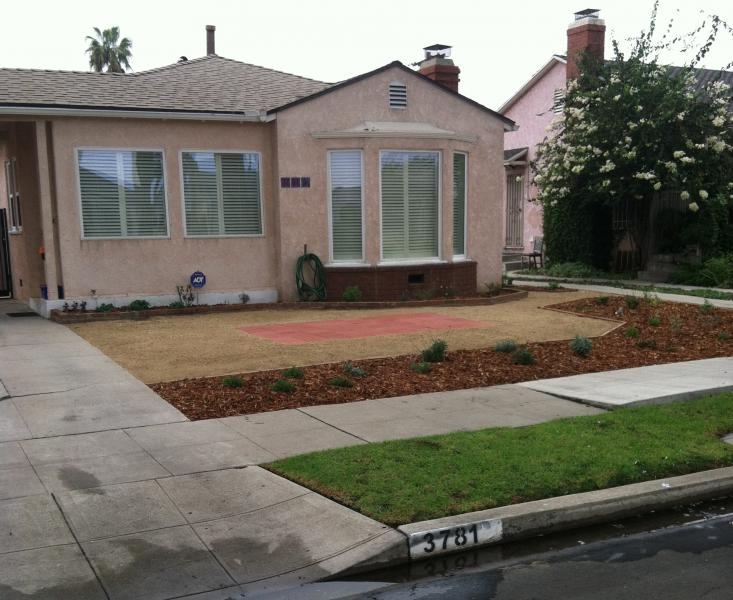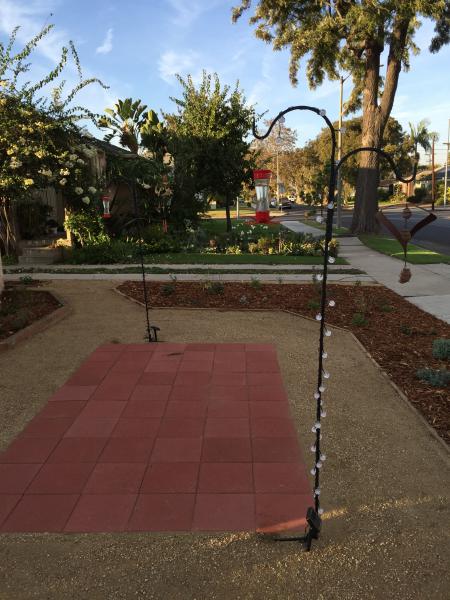 |
| The "after" picture of the Vandergriff-Smith's lawn using water-saving techniques. |
Ah, an expansive lush green front lawn! Every homeowner’s dream, right? Well, we thought so too for 23 years living in our Leimert Park neighborhood in Los Angeles. It was easy to take care of with the gardener cutting and trimming it weekly. We watered once a week with sprinklers and turned them off when it rained. It acted as a generous buffer zone between the house and the sidewalk and all was good.
Or so we thought.
Then we began to make changes in our property in keeping with our commitment to a more sustainable lifestyle. We replaced a section of the backyard driveway area with permeable pavement. We switched our cars to all electric and a plug in hybrid, installing the requisite charging station on the back of the house. Then we moved on to installing solar panels. What next, we thought? What else can we do?
As a member of the Angeles Chapter Water Committee, I wanted to do more to conserve our household water use. We had done much of the inside work already. We installed low water use fixtures such as the toilet and taps. We switched to a shower head that could be turned on and off so our showers became increasingly brief. We invested in a low water use front loading clothes washer and continued to do our dishes by hand, as always. Then there was our water thirsty front lawn, just waiting for a makeover.
 |
| Closeup of the new front yard. |
We saw the lawn removal as an opportunity to decrease our water use and also improve neighborhood life in several ways. We would take out the lawn and plant a California native landscape. By doing so, we would reduce our water use and improve the local ecosystem by attracting butterflies, bees, and birds that have evolved in harmony with these plants.
As a public health nurse, I was concerned that we also try to improve the social connectedness on our block between neighbors by beginning to socialize in the front yard, not the back yard exclusively. We do not have a front porch so the next best thing was to include a patio area in our plans for the front yard makeover and so, by changing the physical environment, we would also change the social environment in a positive way.
Taking action
We knew this makeover was potentially an expensive undertaking which was one reason we had delayed. While there are many sources of do-it-yourself guides for homeowners to make this change (see resource links), we knew as older baby boomers this was not going to be a DIY project for us. We needed expert help.
We live in the city of Los Angeles and heard that the Department of Water and Power (DWP) was offering a rebate of $3 per square foot for turf removal and the planting of a California Friendly garden. Many city water utilities are offering such a rebate. Suddenly, what seemed out of reach financially became possible.
In July 2014, we applied and were approved for the DWP rebate. We submitted “before” pictures and a simple plan. To claim the rebate, we will need to submit “after” pictures and adhere to certain DWP specific guidelines in the installation of our garden. Now the question became, who can we get to do this for us?
I figured we needed the services of a designer and also of a crew knowledgeable about turf removal and changing over the irrigation system from sprinklers to drip. I looked high and low for such a person and crew. I asked around on social media. I put a request up on Craigslist. I checked Angie’s List. What I found was that many landscape architects saw our 1,000 square foot job as too small for them. On the other end of the spectrum, there is a company who will do the job for the price of the DWP rebate received (in our case, about $3,000) but the pictures posted on their website featured lots of white gravel and the company was not committed to using solely California native plants.
I happened to talk with a volunteer at a booth at a sustainability festival who recommended the design firm for her yard in Culver City which was UA Botanical. The chief designer is Ulysses Aban, and, in Ulysses, we had finally found our designer. We met with Ulysses several times and, through emails, hammered out a design plan. He had access to an experienced crew so we were set to go. The plan called for several planting beds, a patio area, and decomposed granite (DG) pathways.
Getting the job done
At the beginning of September, we let our neighbors know to come and claim any azaleas or roses that they wanted from our front planters near the house. These plants were all getting pulled up along with the front lawn. Many neighbors availed themselves of this windfall. We felt some pangs of sadness to see these carefully tended plants go but reminded ourselves we were doing the right thing, and pushed on. The first step was to bring in the turf removal machine and remove all the lawn. What a loud racket it made! This prompted even more neighbors to stop by and ask what we were doing. There was a general positive response but also some head shaking. While the old turf areas were left to sprout their remaining weeds for later removal, work moved on to creating the planting beds and the patio area. The planting beds were framed in redwood 2-by-4-foot pieces to define their edges. The patio area was made with concrete pavers which was an economical choice. They were set without mortar on a sand bed to enable rain to percolate through the patio area rather than run off. This was a DWP requirement but also a feature we would have put in regardless.
To bolster my knowledge of California native plants, I took a five hour introductory class at the Theodore Payne Foundation for Wildflowers and Native Plants on a scorching hot day in Sunland. This was a very helpful class. There I learned it is best not to rototill the soil and disturb its composition. Rototilling also brings up weed seeds to sprout which makes the weed removal process even more difficult. The remaining weeds in our front yard were removed by hand hoeing to prepare the area for planting.
By now, it was the beginning of October and the prime season for planting California native plants. Several of the local native plant nurseries were having sales and our designer was able to stretch our plant budget because of this. Finally, the big day arrived when the plants would be put in and mulched, DG pathways made, and the irrigation system completely redone. What a transformation ensued!
The final result
In all, 72 plants were installed with each requiring its own set of two drip emitters. This meant that the irrigation conversion was a big job. We were very happy to have an experienced crew work this out. Additional valves were installed and connected to the timer with a detailed watering schedule in place until the plants got established. By the end of October, the transformation was complete.
Our designer left us detailed instructions for the care of the plants and we know that we can call on him as needed in the future. We then submitted our “after” pictures to the DWP and are waiting to receive our rebate check. Proceeding as we did, our total cost was about $5,300 with the rebate covering $3,000 of this cost. Engaging the services of a designer, installing a patio, and planting exclusively California natives increased the cost but was worth every penny. We wanted someone to coordinate this project from beginning to end and this worked out well for us. Others may prefer and find success with a completely DIY approach.
| The "before" picture of the lawn. Photos: Courtesy Kathleen Smith |
The bigger picture
Several issues surfaced in the course of completing this project that indicated the need for broader, more systems level societal change to facilitate widespread conversion to native plant yards.
• We are working with our gardener to transition to the care of native plants rather than a lawn. There are legions of gardeners throughout Southern California who make their living cutting grass. They need help to transition to this new form of yard care. This help could come from such agencies as immigrants’ rights groups, day labor site sponsors, and city governments.
• The retail home improvement stores give very little space to California natives and do not label their plants as such. This makes it very difficult for the average homeowner to find native plants and to get the advice they need. This needs to change.
• Those companies who are converting lawns to a drought tolerant landscape need incentives, education, and encouragement to plant natives only.
• The water utilities should provide a list of contractors who are approved to apply for the rebates in the homeowner’s stead and who also are committed to planting California native plants. This is essential for the large group of homeowners, like us, who are not likely to do such a project on their own.
• City government should make it a priority to partner with community based organizations and the private sector to establish retail native plant nurseries throughout Los Angeles. This could be done in conjunction with groups such as North East Trees, TreePeople, and the Conservation Corps. Many jobs could be provided and it would be easier for homeowners and contractors to purchase native plants if there were more such nurseries available.
Resource links
Theodore Payne Foundation for Wildflowers and Native Plants provides classes, retail nursery, public garden, library in Sunland.
Rancho Santa Ana Botanic Garden in Claremont.
Grow Native nursery in Westwood provides classes, retail nurseries, public garden.
California Native Plant Society has local chapters throughout California.
Residential Turf Rebate Program through the Metropolitan Water District for city of Los Angeles residents. Check with your city water utility for the program applicable for your city.
UA Botanical (Ulysses Aban), (310) 482-0698
Helpful books
• California Native Plants for the Garden (7th printing with revisions, 2014). By C. Bornstein, D. Fross, and B. O’Brien. Cachuma Press: Los Olivos, CA.
• California Native Gardening: A Month by Month Guide (2012). By Helen Popper. University of California Press: Los Angeles.
• California Native Landscape: The Homeowner’s Guide to Restoring Beauty and Balance (2013). By Greg Rubin and Lucy Warren. Timber Press: Portland/London.
Kathleen Smith is a member of the Angeles Chapter's Water Committee and public health nurse. You may reach her at smithpublichealth@yahoo.com